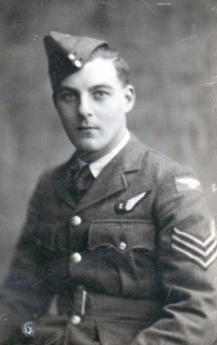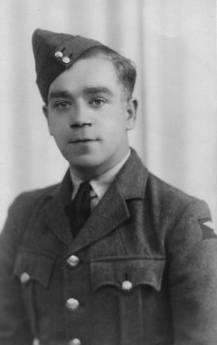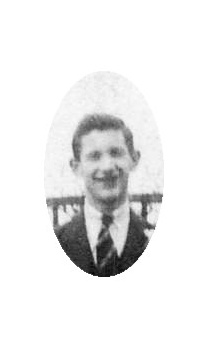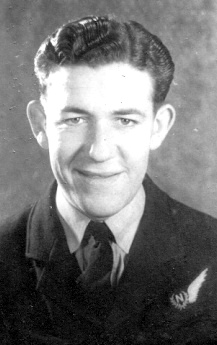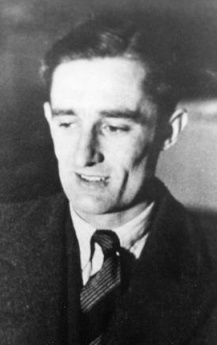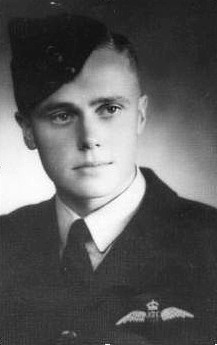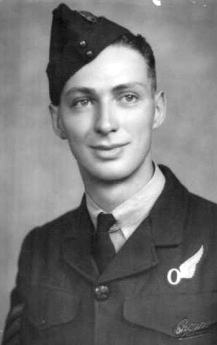The Crew
The crew of HK559 were:
Sergeant Douglas Albert Dawson, 574270 RAF, Flight Engineer, aged 22
Warrant Officer Peter Duff, 1059197 RAFVR, Wireless Operator, aged 34
Sergeant Kenneth Edgar Laxton, 1816757 RAFVR, Rear Gunner, aged 20
Flight Sergeant Ian Harrison Smith, 423913 RAAF, Navigator, aged 21
Sergeant Ernest Edwin Stapley, 1896471 RAFVR, Mid Upper Gunner, aged 35
Pilot Officer John Alan Traill, 423186 RAAF, Pilot, aged 21
Flight Sergeant John William Van Cooten, 426716 RAAF, Bomb Aimer, aged 22
Lancaster crews were formed in two stages during the training programme:
At an Operational Training Unit, all but the flight engineer came together. The process is sometimes described as all the trainees being put in a hangar, and by drifting around for part of a day, self-selecting into congenial teams of six specialists. In reality, it could take longer and some direction from above could be given. For example, Bruce Johnston, another pilot on the Montdidier operation, described in his diary of the time how he acquired his navigator, wireless operator, bomb aimer and mid-upper gunner over several days, and was allocated his rear gunner nearly a month later.
At the subsequent Heavy Conversion Unit, a flight engineer, who had taken a separate course of training, was attached to the established crew. In the case of the seven who died at Gannes there was a further distinction between the flight engineer and the others – while the rest were wartime enlistees in the RAF or RAAF, Douglas Dawson had chosen the RAF as a career in 1938 when he enrolled as an airframe apprentice, aged 16. His ambition to fly was realized only in the later stages of the war when four-engined bombers required a flight engineer in the crew. As well as the geographical spread, the wartime enlistees had a wide variation in what they had been doing immediately before:
Peter Duff was a clerk in the jute business of James Scott and Sons in Dundee.
Kenneth Laxton worked for the family dairy business in Hall Green, Birmingham.
Ian Smith was a trainee engineer with the Sydney Water Board, while taking a degree in Civil Engineering.
Ernest Stapley worked for the London Fire Service.
John Traill was a Trooper in the Australian Army, which he had joined straight from school.
John Van Cooten was the head teacher of the small state school in Pelican, near Chinchilla, Queensland.
However they came together, the crew who died at Gannes were posted in late May 1944 to 115 Squadron at Witchford, by this time equipped only with Lancasters, and flew operations from there. Remarkably, there was another Sergeant Douglas Dawson flying with 115 Squadron at the same time, this one a member of the RCAF. He was a rear gunner who also flew to Montdidier on 17/18 June. He and the rest of his crew were killed three months later on 17 September during an operation to Moerdijk in Holland, and are buried in the nearby village of Strijen, about 30 kilometres to the south of Rotterdam. Tracking this other Douglas Dawson’s history was made harder by his being commissioned some time between the Montdidier and Moerdijk operations - he was a Pilot Officer with a new service number at the time of his death. And there was another Canadian air gunner called Dawson at Witchford in 1944, this one too killed in action later in the year with the rest of his crew.
It sometimes happened that new pilots flew a mission as Second Pilot, displacing the flight engineer from his collapsible seat, to see how experienced crews worked together. This happened to Bruce Johnston, for example, but there is no record that John Traill did so. What is shown in 115 Squadron’s Operations Record Book (ORB) of the time, now in the UK National Archives, is that for him and his crew the Montdidier raid was their fifth operation:
| Date (night of) | Target | Lancaster Serial Code | Number of aircraft returning safely |
|---|---|---|---|
| 30/31 May | Boulogne | ND913 A4-M | 10 from 10 |
| 2/3 June | Wissant | ND760 A4-K | 15 from 15 |
| 14/15 June | Le Havre | ND913 A4-M | 22 from 22 |
| 15/16 June | Valenciennes | ND913 A4-M | 19 from 20 |
| 17/18 June | Montdidier | HK559 A4-H | 13 from 14 |
This detailed official record disagrees with a statement in the brief account of Douglas Dawson’s life which appeared in a local (Ossett) newspaper when he was reported missing, and again when he was presumed killed in action. According to the statement, he flew to Caen on D-Day, 6 June 1944, presumably this being told to his family when he was on leave with them sometime after the event. The ORB shows no operations carried out by Douglas’s regular crew other than those listed above, nor any with him as a member of another crew, though there was an operation with 24 aircraft from 115 Squadron to Ouistreham, the port of Caen, on the night of 5/6 June. It is possible that he flew on this as a stand-in flight engineer for another crew, maybe at the last minute, and for some reason, human error being most likely, this was not properly recorded. ORBs are known to be less than 100% accurate, but typically this means an error in an aircraft’s serial number or an airman’s name spelt wrongly. Completely omitting an aircraft and crew from the account of an operation seems highly unlikely.
Ian Smith's flying log book shows that in addition to the five nighttime operations, two daytime training flights took place:
| 5 June | Formation flying | HK551 A4-T |
| 14 June | Air testing | ND913 A4-M |
Individual photographs
|
|
|
|
(No individual photograph of Kenneth has been found. The one shown here has been extracted from a group at his eldest brother’s wedding, and will not stand further magnification) |
|
|
|
|
|
|
|
Group photographs
All seven had a common deployment from March 1944, but only six appeared in group photographs, either all at once or in a smaller number.
The following two groups are believed to have been photographed at 1657 Heavy Conversion Unit, RAF Stradishall, between March and May 1944:
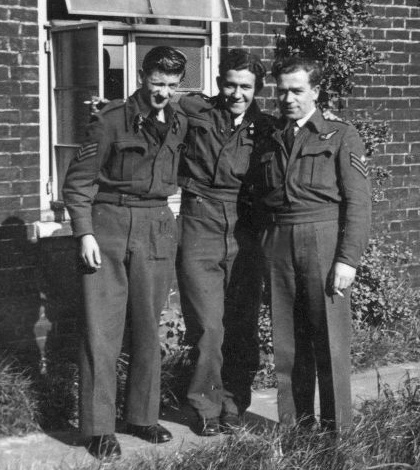
Kenneth Laxton, Ian Smith, Peter Duff
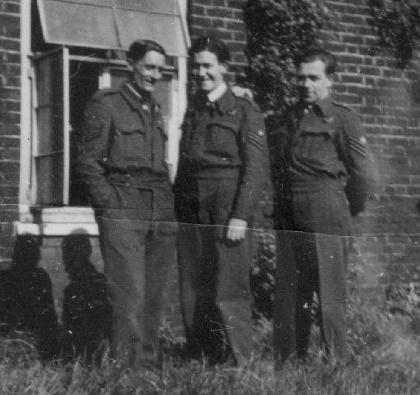
Ernest Stapley, Ian Smith, Peter Duff
This group was on a "battle course", as written on the back of Ian Smith's print, at RAF Methwold in March 1944:

John Van Cooten, Ian Smith, John Traill (rear)
Peter Duff, Kenneth Laxton (front)
The next photograph was taken on a visit to Ely Cathedral in May 1944, and shows the Russian cannon on Palace Green. The cannon was captured during the Crimean War and presented to the city in 1860
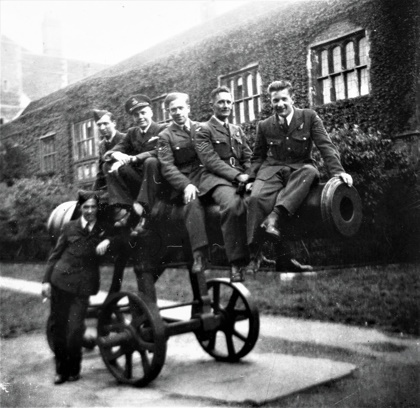
From left to right: Ian Smith, John Van Cooten, John Traill,
Peter Duff, Ernest Stapley, Kenneth Laxton
